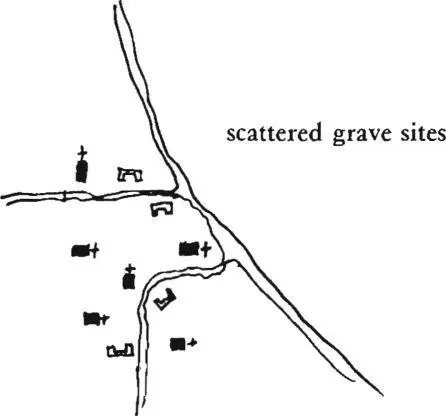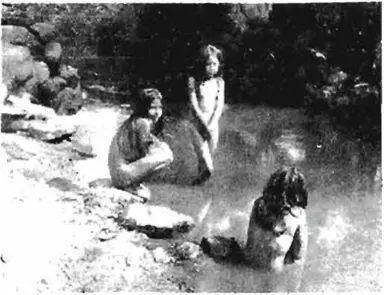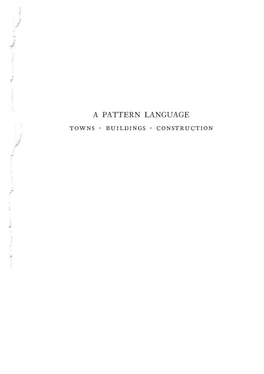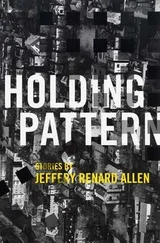Christopher alexander - A pattern language
Здесь есть возможность читать онлайн «Christopher alexander - A pattern language» весь текст электронной книги совершенно бесплатно (целиком полную версию без сокращений). В некоторых случаях можно слушать аудио, скачать через торрент в формате fb2 и присутствует краткое содержание. Жанр: Прочая научная литература, на английском языке. Описание произведения, (предисловие) а так же отзывы посетителей доступны на портале библиотеки ЛибКат.
- Название:A pattern language
- Автор:
- Жанр:
- Год:неизвестен
- ISBN:нет данных
- Рейтинг книги:3 / 5. Голосов: 1
-
Избранное:Добавить в избранное
- Отзывы:
-
Ваша оценка:
- 60
- 1
- 2
- 3
- 4
- 5
A pattern language: краткое содержание, описание и аннотация
Предлагаем к чтению аннотацию, описание, краткое содержание или предисловие (зависит от того, что написал сам автор книги «A pattern language»). Если вы не нашли необходимую информацию о книге — напишите в комментариях, мы постараемся отыскать её.
A pattern language — читать онлайн бесплатно полную книгу (весь текст) целиком
Ниже представлен текст книги, разбитый по страницам. Система сохранения места последней прочитанной страницы, позволяет с удобством читать онлайн бесплатно книгу «A pattern language», без необходимости каждый раз заново искать на чём Вы остановились. Поставьте закладку, и сможете в любой момент перейти на страницу, на которой закончили чтение.
Интервал:
Закладка:
The procedures for each of these three scales are described in much more detail with extensive examples, in the appropriate chapters of The Timeless Way of Building . For the town—see chapters 24 and 25; for an individual building—see chapters 20, 21, and 22; and for the process of construction which describes the way a building is actually built see chapter 23.
xl
been completely undermined. What were once beautifully simple forms of mourning have been replaced by grotesque cemeteries, plastic flowers, everything but the reality of death. And above all, tile small graveyards which once put people into daily contact with the fact of death, have vanished—replaced by massive cemeteries, far away from people’s daily business.
What must be done to set things right? We can solve the problem by fusing some of the old ritual forms with the kinds of situations we face today.
1. Most important, it is essential to break down tire scale of modern cemeteries, and to reinstate the connection between burial grounds and local communities. Intense decentralization: a person can choose a spot for himself, in parks, common lands, on his land.
2. The right setting requires some enclosure; paths beside the gravesites; the graves visible, and protected by low walls, edges, trees.
3. Property rights. There must be some legal basis for hallowing small pieces of ground—to give a guarantee that the ground a person chooses will not be sold and developed.
4. With increasing population, it is obviously impossible to go on and on covering the land with graves or memorials. We suggest a process similar to the one followed in traditional Greek villages. The graveyards occupy a fixed area, enough to cope with the dead of 200 years. After 200 years, remains are put out to sea—except for those whose memory is still alive.
5. The ritual itself has to evolve from a group with some shared values, at least a family, perhaps a group that shares a religious view. Three of the basics: friends carrying the casket through the streets in procession; simple pine coffins or urns; gathering round the grave.
Therefore:
Never build massive cemeteries. Instead, allocate pieces of land throughout the community as grave sites—corners of parks, sections of paths, gardens, beside gateways—where memorials to people who have died can be ritually placed with inscriptions and mementos which celebrate their life.
70 GRAVE SITES
Give each grave site an edge, a path, and a quiet corner where people can sit. By custom, this is hallowed ground.

*$♦ v
If possible, keep them in places which are quiet—quiet backs (59) ; and provide a simple seat or a bench under a tree, where people can be alone with their memories—tree places (171), seat spots (241). . . .
| 71 STILL WATER* |
|---|
 |
358
. . . the patterns access to water(25) and tools and streams(64) provide a variety of kinds of water throughout the community. This pattern helps to embellish the still waters—the pools and ponds and swimming holes—and provide them with a safe edge for children. It also helps to differentiate the public space in house cluster(37), work community(41), health CENTER(47), COMMON LAND(67), LOCAL SPORTS(72) .
To be in touch with water, we must above all be able to swim; and to swim daily, the pools and ponds and holes for swimming must be so widely scattered through the city, that each person can reach one within minutes.
We have already explained, in pools and streams(64), how important it is to be in touch with water—and how the ordinary water of an area can, if left open, be a natural component of the everyday ecology of a community.
In this pattern we go a little further, and put the emphasis on swimming. On the one hand, adults cannot have any substantial contact with water unless they can swim in it, and for this purpose the body of water must be large enough and deep enough to swim in. On the other hand, the highly chlorinated, private, walled, and fenced off swimming pools, which have become common in rich people’s suburbs, work directly against the very forces we have described in pools and streams(64), and make the touch of water almost meaningless, because it is so private and so antiseptic.
We believe that the swimming cannot come into its proper place, unless everyone who wants to can swim every day: and this means, that, to all intents and purposes, there needs to be a swimming pool on every block, almost in every cluster, and at least in every neighborhood, within no more than about 100 yards of every house.
In this pattern, we shall therefore try to establish a model for a kind of “swimming hole”: public, so that it becomes a communal
function, not a wholly private one; and safe, so that this public water can be deep enough for swimming without being dangerous to tiny children playing at the edge.
For millions of years, children have grown up in perfect safety along the edge of oceans, rivers, and lakes. Why is a swimming pool so dangerous? The answer depends simply on the edge.
 |
| . . . the edge . . . |
As a rule, the natural edges between water and shore are marked by a slow, rough transition. There is a certain well-marked sequence of changes in materials, texture, and ecology as one passes from land to water. The human consequences of this transition are important: it means that people can walk lazily along the edge, without concern for their safety; they can sit at the edge and have their feet in the water, or walk along with the water around their ankles.
Children can play in the water safely when the edge is gradual. A baby crawling into a lake comes to no abrupt surprises; he stops when the water gets too deep, and goes back out again. It has even been shown that children teach themselves to swim when they are free to play around a pool with an extremely gradual slope toward the deep. In such a pool, some children have even learned to swim before they can walk. Even the rocks at the steep edge of a rock-bound lake are not that surprising—because the sandy earth further from the edge gives way to rocks, which change their angle and their texture, as one comes to the sharp edge.
But a swimming pool, and any kind of water with a hard and artificial edge, has none of this gradualness. A child may be run-
360
ning along, at top speed, when splash, suddenly he finds himself in six feet of water.
The abrupt edge, most serious for children, has its effects in psychological terms for adults too. Although they are not literally endangered by the edge—since they can learn its dangers—the presence of an ecologically wrong kind of abruptness is disconcerting—and destroys the peace and calm which water often has.
It is therefore essential that every water’s edge, whether on a pond, or lake, or swimming pool, or river, or canal, be made so that it has a natural gradient, which changes as a person comes up to the edge, and goes on changing as the water is first very shallow, and then gradually gets deeper.
Читать дальшеИнтервал:
Закладка:
Похожие книги на «A pattern language»
Представляем Вашему вниманию похожие книги на «A pattern language» списком для выбора. Мы отобрали схожую по названию и смыслу литературу в надежде предоставить читателям больше вариантов отыскать новые, интересные, ещё непрочитанные произведения.
Обсуждение, отзывы о книге «A pattern language» и просто собственные мнения читателей. Оставьте ваши комментарии, напишите, что Вы думаете о произведении, его смысле или главных героях. Укажите что конкретно понравилось, а что нет, и почему Вы так считаете.












